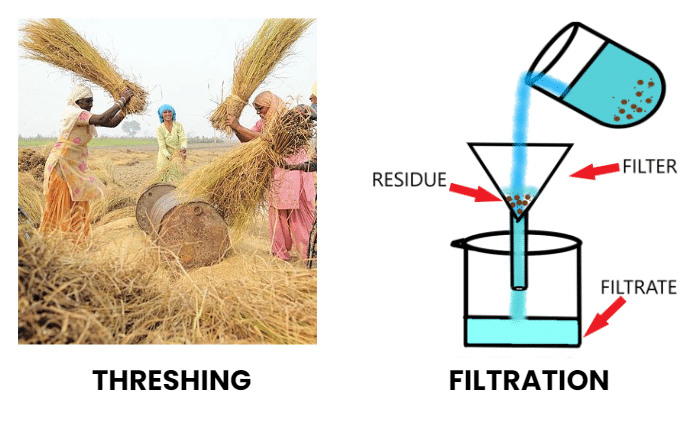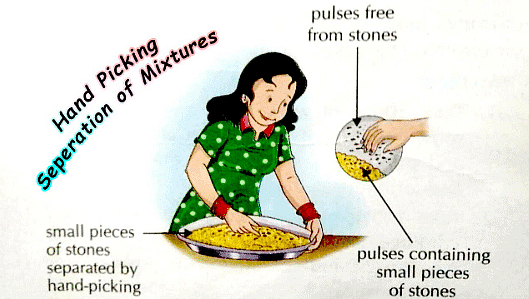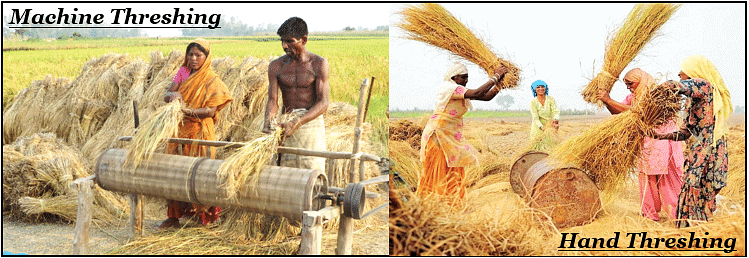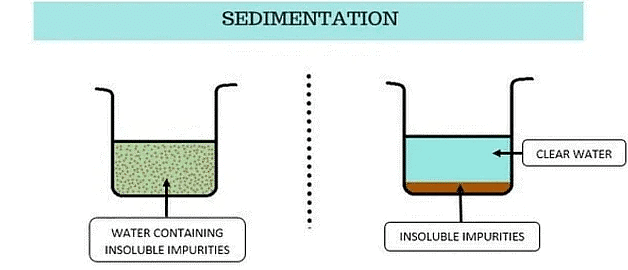Class 6 Science Chapter 3 Question Answers - Separation of Substances
Q1: How does the farmer separate grains seeds from bundles of stalk?
Ans: By threshing farmer can separate grain seeds from bundles of stalk.
Q2: Handpicking can be used only when the quantity of impurities is NOT very large. (TRUE/FALSE)
Ans: True
Handpicking is practical only for small amounts of impurities. For larger quantities, other methods are more efficient.
Q3: Name any two methods used for the separation of substances.
Ans: Threshing and filtration
- Threshing is a method used to separate grain seeds from the stalks after harvesting. The stalks are beaten or threshed to free the seeds.
- Filtration is a method used to separate solid particles from a liquid. For example, it is used to remove tea leaves from tea by passing the mixture through a strainer.
Q4: Which method is used to separate stones from grains?
Ans: Handpicking
Handpicking is a simple method used to remove small stones or other impurities from grains. This method is practical when there are only a few stones mixed with the grains, making it easy to pick them out by hand.
Q5: Which method is used to separate heavier and lighter component of a mixture by wind or blowing air?
Ans: Winnowing
Winnowing uses the wind to blow away lighter components, like husk, leaving the heavier components, like grains, behind.
Q6: The method in which stalks are beaten to free the grain seeds is called______________.
Ans: Threshing
Threshing is done by beating the stalks to separate the grains from the plant. This process helps in collecting the grains efficiently.
Q7: Heavier and lighter components of a mixture can be separated by winnowing. (TRUE/FALSE)
Ans: True
Winnowing uses wind or air to separate heavier particles (like grains) from lighter ones (like husks). The wind blows away the lighter particles, leaving the heavier ones behind.
Q9: The method by which impurities and bran can be removed from the flour is ______________.
Ans: Sieving
Sieving involves passing flour through a mesh or sieve to remove impurities and bran. The fine flour passes through the mesh, while larger particles like bran are left behind.
Q10: When a heavier component of a mixture settles after water is added to it, it is called____________.
Ans: Sedimentation
Sedimentation is when heavier particles in a mixture settle at the bottom after water is added.
Q11: What is decantation?
Ans: The process in which water is removed when a heavier component of the mixture settles is called decantation.
Q12: The two liquids that do not mix with each other can be separated by____________.
Ans: Decantation
Decantation is used to separate two liquids that do not mix, like oil and water. You carefully pour off the top liquid, leaving the other behind.
Q13: Which method of separating tea leaves from prepared tea is better: filtration or decantation?
Ans: Filtration
Filtration is better for separating tea leaves from tea because it uses a filter to catch the leaves while letting the liquid pass through. This method is more effective than decantation for this purpose.
Q14: Husk from wheat can be separated by ______________.
Ans: Winnowing
Winnowing is used to separate the husk from wheat. By blowing air through the mixture, the lighter husk is carried away while the heavier wheat grains fall down.
Q15: What is evaporation?
Ans: The process of conversion of water into its vapour is called evaporation.

Q16: The method of filtration is also used in the process of preparing cottage cheese in our homes. (TRUE/FALSE)
Ans: True
Filtration is used to separate the liquid whey from the solid curds when making cottage cheese. The curds are strained through a cloth or filter to remove the whey, leaving behind the cottage cheese.
Q17: Salt comes from sea water. (TRUE/FALSE)
Ans: True
Salt is obtained from seawater through evaporation. When seawater evaporates, salt remains behind, which can then be collected and used.
Q18: How can sand be separated from water?
Ans: Sand can be separated from water by sedimentation.
Q19: How can we separate salt from water?
Ans: By evaporation
 Q20: Water dissolves different amounts of soluble substances in it. (TRUE/FALSE)
Q20: Water dissolves different amounts of soluble substances in it. (TRUE/FALSE)
Ans: True
Water dissolves different amounts of substances based on the type of substance and temperature.
Q21: Water drops condensed under a plate that has been used to cover a vessel containing milk that has just been boiled. This is due to ____________.
Ans: Condensation.
When the hot steam from the milk touches the cool plate, it turns back into water droplets. This process is called condensation.
Q22: A number of substances can be dissolved in a solution by heating it. (TRUE/FALSE)
Ans: TRUE
Heating a solution helps dissolve more substances because it increases the solubility of solids in liquids.
Q23: Does the water dissolve an equal amount of different soluble substances?
Ans: No
Water does not dissolve the same amount of all soluble substances; the amount depends on the substance's solubility in water.
Q25: We dissolve salt in water. By what way the same amount of water could be made to dissolve more salt before getting saturated?
Ans: On heating the water
Heating the water increases its temperature, which helps it dissolve more salt before reaching saturation.
Q26: How is a solution prepared?
Ans: A solution is prepared by dissolving a substance (solute) in a liquid.
Q27: Which of the following is NOT a method of separation of substances:
Threshing, filtration, saturated solution, sedimentation
Ans: Saturated solution
Q28: To separate dust and soil particles from rice, water is added. Then the vessel is tilted to pour out the dirty water. This is an example of ____________.
Ans: Sedimentation.

Q29: Which step is used first to separate a mixture of salt and camphor?
1. Evaporation
2. Sublimation
3. distillation
4. Filtration
Ans: Sublimation
To separate salt and camphor, first use sublimation to remove camphor, as it turns into vapour.
Q30: The technique that separates a liquid from an insoluble solid by carefully pouring off the liquid is called ____________.
Ans: Decantation
Decantation separates a liquid from a solid by gently pouring off the liquid.
Q31: If you cannot find a strainer or a clean piece of cloth while making a tea in which you added tea leaves. What method would you like to apply for a cup of tea without leaves?
Ans: Decantation
Q32: Take 3 glasses of water. Add two teaspoons of sugar in the first glass, four teaspoons of sugar in the second glass, and six teaspoons of sugar in the third glass. Which one is most saturated:
A) First glass
B) Second glass.
C) Third glass
Ans: C
The third glass is the most saturated because it contains the highest amount of sugar (six teaspoons). Saturation occurs when no more solute (sugar) can dissolve in the solvent (water).
Q33: Grapes can be separated from the mixture of nuts and grapes by ____________.
Ans: Handpicking
Q34: Water and milk are mixed in a glass. This mixture can be separated by filtration. (TRUE/FALSE)
Ans: False
Filtration is used to separate solids from liquids, but water and milk are both liquids that mix well together. Therefore, they cannot be separated by filtration.
Q35: If a salt is completely dissolved in water, is it possible to separate salt from water by filtration?
Ans: No
Filtration can't separate salt from water because the salt dissolves completely, forming a solution. Filtration is only effective for separating insoluble solids from liquids, not dissolved substances.
|
100 videos|261 docs|49 tests
|
FAQs on Class 6 Science Chapter 3 Question Answers - Separation of Substances
| 1. What is meant by the term "separation of substances"? |  |
| 2. What are the different methods used for the separation of substances? |  |
| 3. How does filtration work in the separation of substances? |  |
| 4. When is distillation typically used for the separation of substances? |  |
| 5. How does chromatography help in the separation of substances? |  |

|
Explore Courses for Class 6 exam
|

|























